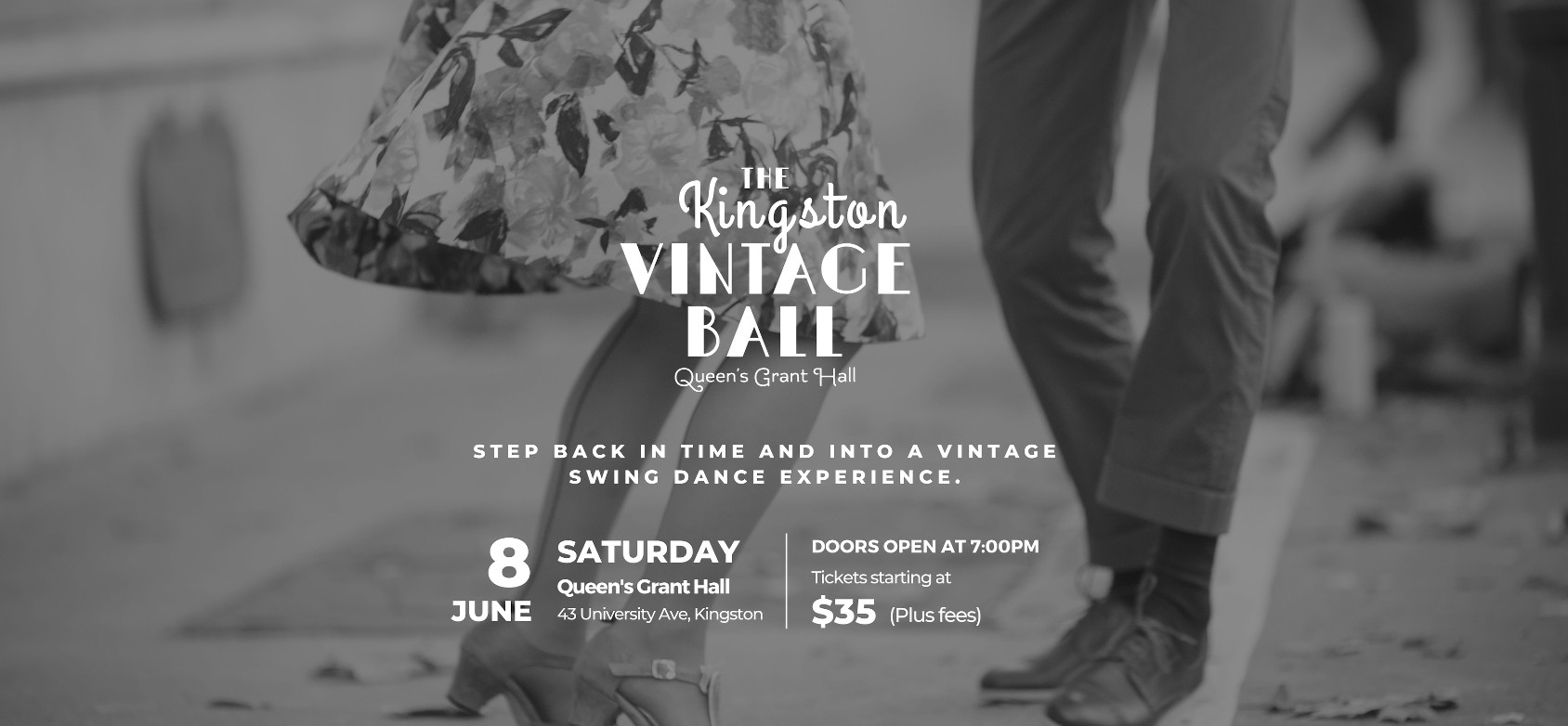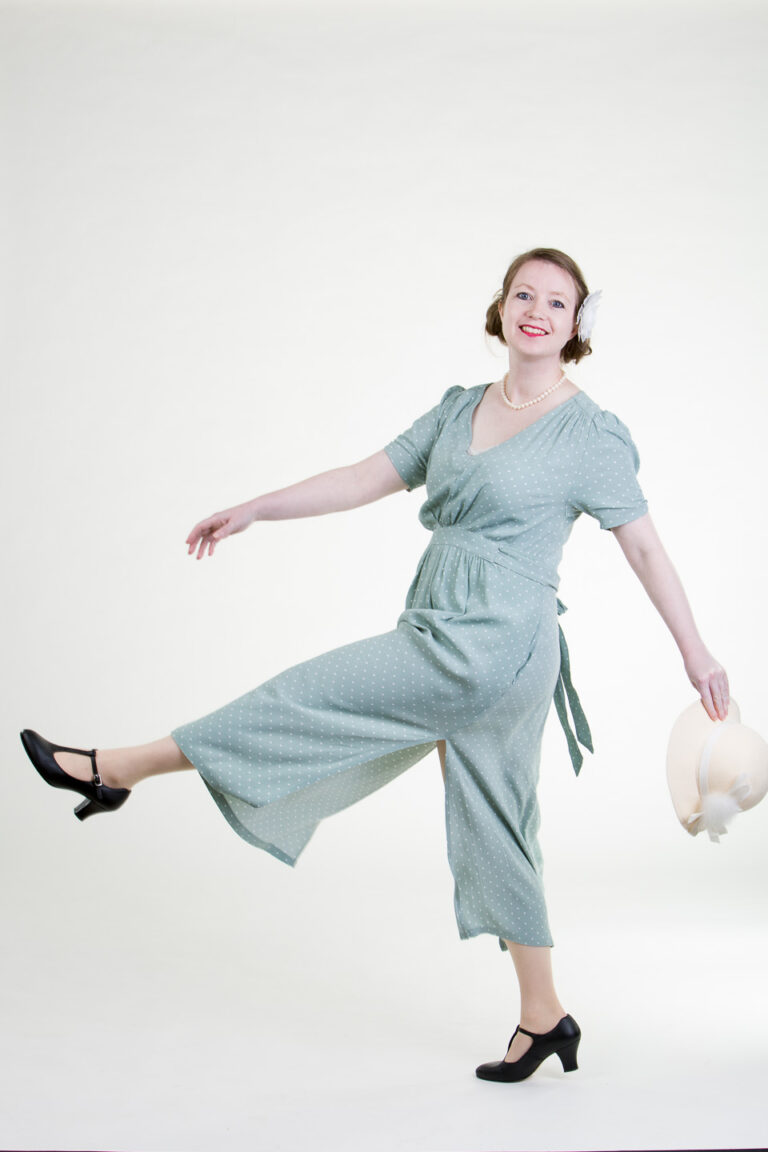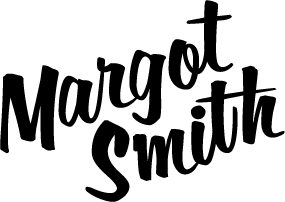
About
Margot Smith has been dancing vintage swing dances since 2008 and is the current director of Kingston’s vintage swing dance studio, Margot Smith Dance. In class she emphasizes inclusion, respect, and fun. She challenges dancers to develop their dance skill sets and to explore their individual dance personality. Margot strives to empower dancers to reach their dance goals, whatever they may be, and to have the confidence to take on these challenges.
Vintage swing dancing isn’t everyone’s thing, but we want to offer a place for you to explore these styles of dance comfortably where you can invite friends to challenge themselves and learn something new.
If vintage swing dancing is your thing and you dream it, triple step when you walk, and have more vintage clothes than modern, we also want to ensure you have ample opportunities to enjoy your passion within a supportive community. We strive to achieve this through quality learning environments, exposure to diverse dance repertoires, and by encouraging dancers to help form the types of dance experiences they seek.


Lessons
Stay tuned for more lessons coming your way.
Sign up on our email list to get notification of new dance opportunities.
Private lessons are available on Sunday afternoons by request.
- Lessons are for 1-4 people. Larger groups can be accommodated on request
- Held at Dance Xtreme Studio, 17538 Highway 2, Quinte West, Ontario.
- Private lesson fee is $60/hour. Cash only.
Four-week 6 count Lindy Hop program starts on Sunday, February 18, 2024 in Kingston, Ontario!
- Classes run four consecutive Sundays from 12:30 p.m. to 1:30 p.m., with the first class on February 18, 2024.
- Tuition is $60 for the four weekly lessons.
- No experience or partner is necessary.
- Classes held at the Kingston School of Dance, 370 King St. W. #303, Kingston, ON K7L 2X4
- Sign up today at kingstonschoolofdance.ca
Beginner Collegiate Shag Workshop at Queen’s Swing Dance Club
- Saturday, March 9th from 11AM to 1PM at The Spire
- We’re going for it! Collegiate shag is a fun high energy partnered dance built for speed. Whether you are new to swing dance or a seasoned lindy hopper collegiate shag will add that extra hop and skip to your step. In this series we will give you the fundamental skills you need to collegiate shag your way through an awesome social dance. Don’t take our word for it, take a look at this demo and see for yourself.
- Tuition is $20 for QSDC members, $25 for students, and $30 for community members .
- No experience or partner necessary. See you there!
Lesson Descriptions
This is where we get started. No experience required. These are lessons where we introduce the fundamentals of rhythm, connection, movement, musicality, and patterns. We strive to give you the confidence and knowledge to tackle the social dance floor and a strong foundation of fundamentals to build your dance mansion on. Join this level any time to get started.
In this level we start to turn the heat up and explore more challenging concepts and sequences. To achieve the greatest success at this level it is important that you have a strong foundation of the fundamentals and are comfortable with basic 6-count lindy hop, 8-count lindy hop, and charleston patterns at medium tempos. Transitioning between these basics may still cause some hiccups but that is where we come in. At this stage, you will be out social dancing at least a few times a month to rock your skills on the dance floor.
Dancers at this level will have been dancing for more than two years, have strong lead/follow skills, social dance regularly, and are looking to continue developing the quality of their movement, rhythm, and connection through more challenging patterns and concepts. Here we will incorporate more nuanced ways of self expression and musicality that complement the partnership while social dancing.
The Kingston Vintage Ball
SATURDAY, JUNE 8, 2024
7 PM – 12 AM
Queen’s Grant Hall (43 University Ave, Kingston, ON)
Step back in time and into a vintage swing dance experience at the Queen’s Grant Hall. Discover this unforgettable historic space before strolling your way to our photo booth to sit for a portrait and take in an elegant evening of vintage dance, music, fashion, film, and local history.
Learn to Lindy Hop with our drop-in beginner lesson. No partner needed, no experience required. We are here to get you started off on the right foot (literally). If dancing isn’t your thing, pull up a chair and enjoy the musical entertainment of our guest band.
We are excited to welcome The Commodores’ Orchestra from Belleville, ON to bring their vintage big band sound to our dance floor. The Commodores are celebrating their 97th year and have recently published a book on the bands characters and stories. Come experience that classic big band sound with The Commodores’ Orchestra and kick up your heels to some swingin’ beats.
- 7:00 PM Doors Open
- 7:30 PM Drop-In Beginner Dance Lesson
- 8:00 PM – 11:00PM The Commodores’ Orchestra
Dance: $50 (plus fees) / $60 at the door (cash only)
Keep up with the conversation by following us on social media as we count down to June 8th.
https://www.facebook.com/events/7858305624199460
Saturday Night Social
We host a DJ’d social dance at Trenton Town Hall – 1861 on one Saturday each month. No partner needed, no experience required! This is a great opportunity to try vintage swing dances and see what it is about or bring a friend and show them what you boogey down to. See you there!
The next dance will be in April 2023. Date to be announced.
- 7:00-7:30PM – Drop-In Beginner Swing Dance Lesson
- 7:30-9:00PM – DJ’d Social Dance
Admission: $10 (Cash only, please)
Location: Trenton Town Hall, 55 King Street, Trenton, Ontario, Canada
Swing Dance Facts
Swing dancing first originated in the 1920’s and evolved with big band and jazz music through to its height of popularity in the 1940’s. Swing dancing is an umbrella term for a number of dance styles including lindy hop, charleston, balboa, and authentic jazz which are danced to music with a lilting swing tempo. The dance was born from young people modifying their dance steps to grow with the rapidly changing music scene. This created a partner dance which emphasizes expression, personality, musicality, and lead/follow connection technique needed for unchoreographed social dancing. Moreover, this dance was meant to be shared with your peers at a music hall, and is not focused on competition technique. Popular films and soundtracks such as The Great Gatsby, The Notebook, Pearl Harbour, Chicago, and A League of Their Own feature period dancing and have helped to rejuvenate exposure to such a wonderful era of dancing and music.
Social dancing happens when you are dancing socially with your friends. This is true whether you foxtrot, krump, hustle, dougie, pirouette, or funky chicken across the dance floor. We provide the music, you bring the moves. In our case, we play big band swing and jazz music which is appropriate for swing dancing. Because swing dancing is generally a partner dance people start by asking one another for a dance when a song comes on. This is a good way to practice what you learn in class or learn some new moves. At the end of the song the dancers thank one another and continue on. This can be an intimidating step, but we have all been fledgling dancers at one time and it’s ok to let people know you are a beginner. Then just dance! That’s what we are all here for!
Etiquette
Personal hygiene is key. This includes fresh breath, deodorant, clean shirts, the works. Minimal fragrances is also important for anyone who may have an allergy.
We all sweat. The more you dance, the more you sweat, it’s been proven. When dancing with other people it is good to remember to keep it fresh, change it up now and then, and bring a few spare shirts. Easy, breezy… dry.
There is a happy middle zone here. Too much eye-contact may seem creepy and no eye-contact may seem like you are not enjoying the dance. Everyone is different, but be wary to avoid any stare downs when dancing with another person.
When asking others to dance (and we hope you do) a simple, “Would you like to dance?” often has a high success rate. Less direct approaches may be unwelcome and will set the dance off on a bad foot (figuratively and/or literally). At a social dance it is safe to assume most people are there to dance and you can ask anyone for a dance and that goes for both leads and follows. If someone politely refuses a dance don’t ask again that night. Remember that some people may be shy or nervous and we want them to feel welcome to join in the fun at their own pace.
Well you really have two options here, accept or refuse. To accept a dance a simple, “Yes, thank you” will do the trick and together you find an empty space on the dance floor. If you are uncomfortable accepting a dance for any reason, whether you are nervous, tired, injured, or just content watching this is your right and you do not need to feel obliged to accept. We encourage you to accept dances, but your enjoyment and personal safety are our top priority. You can always tell someone you will find them later, but if you go this route be sure to hold true to this and ask them for a dance when you can. It is also considered extremely rude to refuse a dance with one person and accept a dance with another person during that same song. If you refuse one person, for whatever the reason, it is best to sit that song out. Ok, that seems really complicated, but it’s not. Just do what is right for you, because that is what is most important.
At the end of the song, always thank your partner. If you enjoyed the dance, you can always ask them to dance again, but never assume that you will dance together for the next song.
Any and all aerials are strictly forbidden on the social dance floor. This is to protect unsuspecting participants and surrounding dancers. An aerial is defined as a move where the follower’s feet leave the floor and they are not in control of their own weight.
People are moving, things happen, and minor collisions do occur. If you find yourself in this situation, always take a moment to ensure everyone is uninjured and to offer a brief apology. The best offense is a good defense, and solid floor craft is key. Everyone really appreciates this. Look out for your partner and take care when navigating the dance floor.
There are many types of shoes that are good for dancing, but always wear clean shoes on the dance floor. This protects the floor and other people’s shoes and helps us get invited back to dance at the venue.
It is considered very rude to instruct any dancer while dancing socially. The only time this is acceptable is if someone invites you to provide comment on their dancing and you are experienced enough to provide positive constructive feedback.
If someone is doing something that is making you uncomfortable in absolutely any way it is important you voice your concern, no questions asked. This could be something like, “Sorry I don’t know that move” or “I have a bad back so no dips please”. This doesn’t mean the end of the dance, it’s just you letting the other person know your personal boundaries and it always makes the dance better. Almost all dancers will be happy you said something because no one wants you to leave the dance floor uncomfortable.
If you ever feel these rules of dance etiquette are not being practiced by any dancer, please bring it to the attention of one the instructors so we can address the issue and ensure any problems do not persist. Now stop reading and go dancing!
Hockey
Hockey is a fast, improvised sport. Players are required to think on their feet and react to the game as it unfolds. These skills are not unlike skills needed for jazz dances like Lindy Hop. Players need to communicate with their teammates, express themselves in the game and keep up with the pace of play.
I am interested in hockey and creativity. My background in dance, music, sport, and science allows me to bring my creativity experiences to hockey. My creativity programming includes on and off ice components. Please reach out if you would like to discuss how you can add creativity training to your regular hockey programming.

